This guide explains scoping and technical requirements for accessible routes in the ABA Standards.
Where Required: Site Arrival Points
At least one accessible route must be provided within the site to accessible facility entrances from these site arrival points, where provided:
- accessible parking and accessible passenger loading zones
- public streets and sidewalks
- each public transportation stop.
Accessible Routes from Site Arrival Points
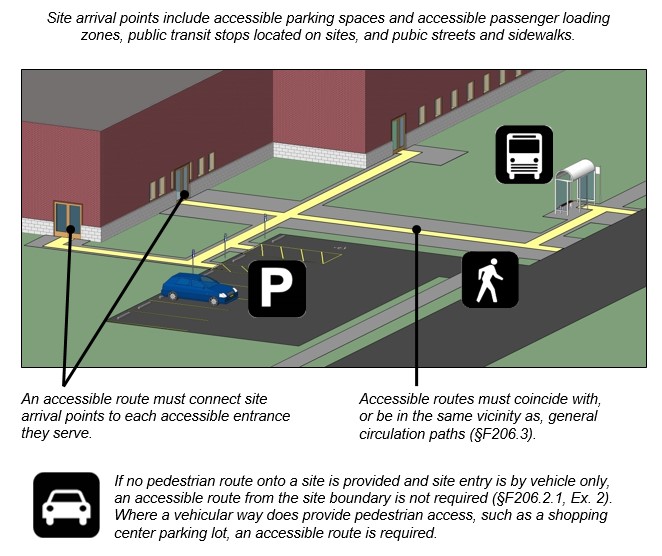
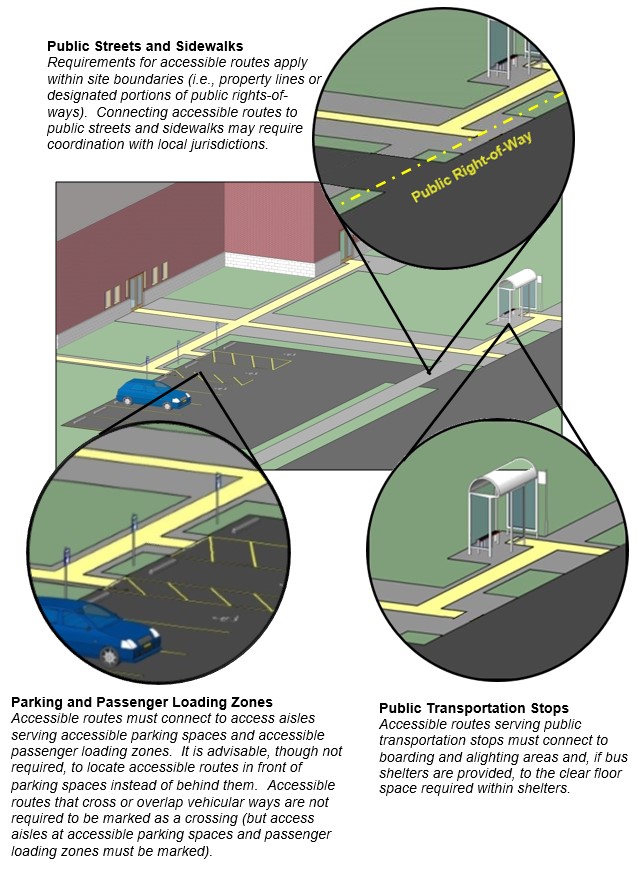
Accessible Routes within a Site
At least one accessible route within the boundary of the site originating from site arrival points must connect all accessible buildings, facilities, elements, and spaces on a site.
Accessible Routes (Exterior) within a Site
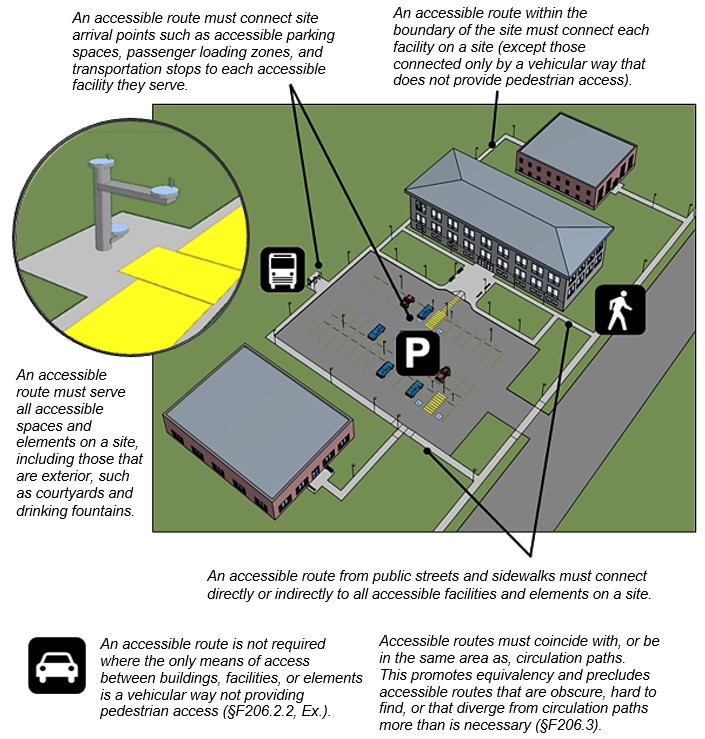
Accessible Routes within a Building or Facility
At least one accessible route must connect all accessible spaces and elements. If a circulation path is interior, the accessible route also must be interior. Accessible vertical interior circulation must be in the same area as stairs and escalators, not isolated in the back of the facility.
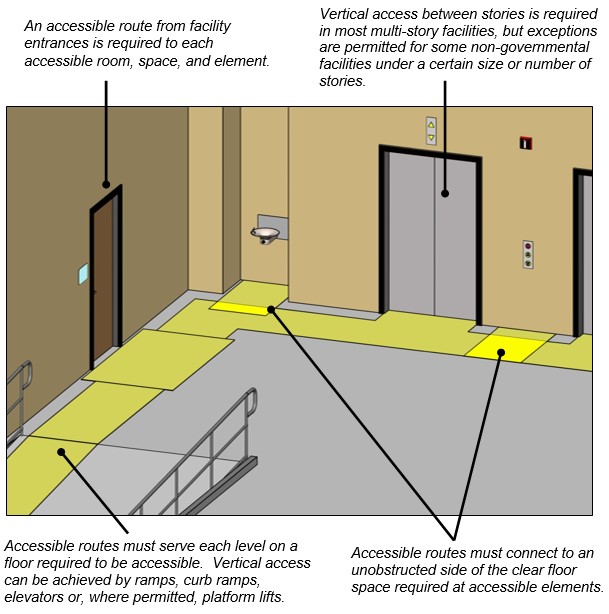
Where Required: Multi-Story Buildings and Facilities
An accessible route must connect each story and mezzanine in a facility unless an exception applies. However, if a building does qualify for an exception in the Standards:
- all other provisions in the Standards still apply to stories and mezzanines not served by an accessible route
- elevators provided anyway must fully comply (as standard or LULA elevators)
- vertical access still may be required by an applicable state or local code.
An accessible route between stories is required in multi-story facilities except those with no more than two stories where the inaccessible story above (or below) the entry level has no public use space and an occupant load of five maximum.
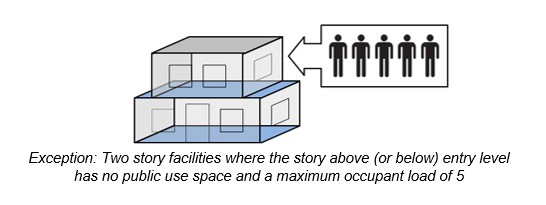
Exceptions for Specific Occupancies [§F206.2.3]

The Standards also include limited exceptions for accessible routes between stories in air traffic control towers and, under certain conditions, detention and correctional facilities, residential facilities, multi-story transient lodging guest rooms, and qualified historic facilities.
Mezzanines (Private and Public Sector Facilities)
An accessible route must serve mezzanines in multi-story facilities where vertical access between stories is required or provided. An accessible route to mezzanines is not required in:
- single story facilities (mezzanines do not count as a story) or
- facilities that are exempt from the requirement for an accessible route between stories (additional conditions apply to restaurants and cafeterias).

Alterations and Additions
In alterations to multi-story facilities, an accessible route to stories and mezzanines is required where a stair or escalator is provided where none existed previously and major structural modifications are necessary (§F206.2.3.1). The accessible route must connect each level served by the new stair or escalator (except where a compliant connecting accessible route already exists).
An accessible route to stories or mezzanines may be required as part of an accessible path of travel to primary function areas that are altered (§F202.4). Alterations involving primary function areas must include an accessible path of travel that extends to site arrival points to the extent that the cost is not “disproportionate” (i.e., more than 20% of the total cost of alterations to the primary function area).
Exceptions for accessible routes between stories and to mezzanines permitted in new construction apply fully to alterations, including those that trigger an accessible path of travel to a primary function area.
When Accessible Routes to Stories/ Mezzanines are Required in Alterations or Additions
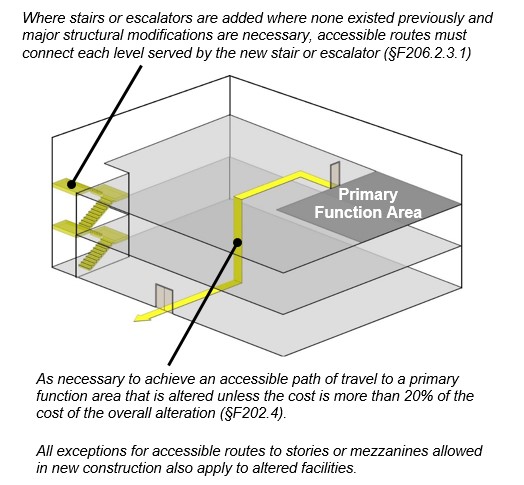
Accessible Routes to Accessible Spaces and Elements
An accessible route must connect accessible facility entrances with all accessible spaces and elements in a facility that are connected by a circulation path (§F206.2.4). Exceptions for accessible routes to stories and mezzanines (§F206.2.3 and §F206.2.4, Ex. 3) do not extend to level changes within a story or mezzanine that are part of a required accessible route to spaces or elements. These exceptions apply only to the portions of an accessible route that connect stories or that connect a story and mezzanine.
Dining Areas in Restaurants and Cafeterias
In newly built restaurants and cafeterias, an accessible route must serve all dining areas, including those that are raised or sunken or located outdoors (§F206.2.5). If a story or mezzanine is exempt from the requirement for vertical access, an accessible route within each story or mezzanine is still required to connect dining areas and other spaces and elements even though an elevator (or ramp) does not serve the story or mezzanine.
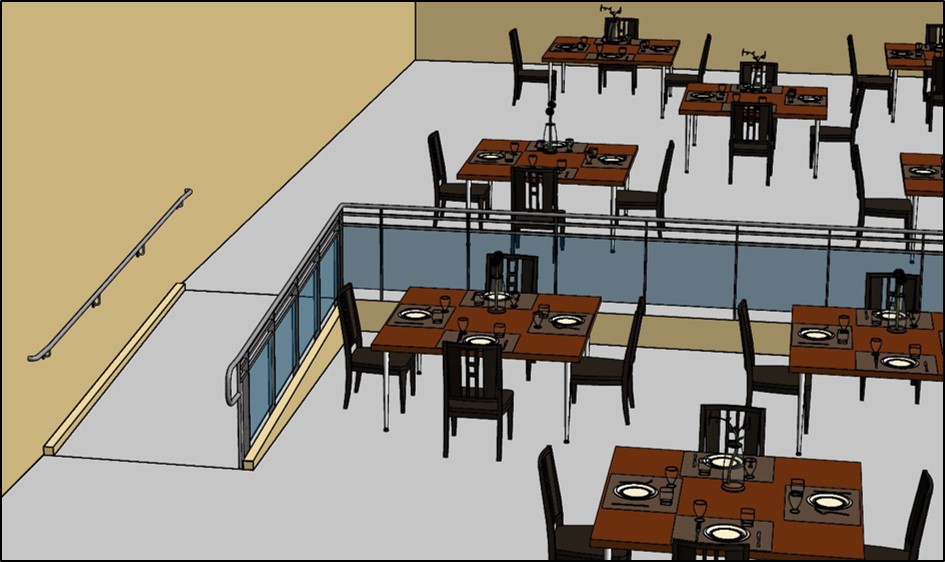

Performance Areas
An accessible route must connect stages and other performance areas directly to seating areas where they are directly connected by a circulation path as well as to dressing rooms and other ancillary spaces used by performers (§F206.2.6).
Press Boxes
An accessible route is required to press boxes except where the aggregate area of all press boxes serving a playing field or assembly area is no more than 500 sq. ft. if press boxes are either:
- free-standing and elevated above grade at least 12’ or
- located in bleachers with points of entry on one level.
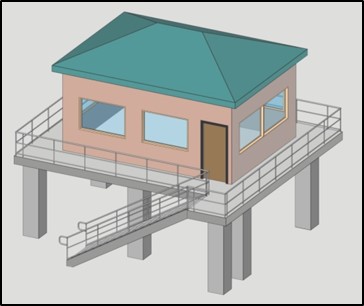
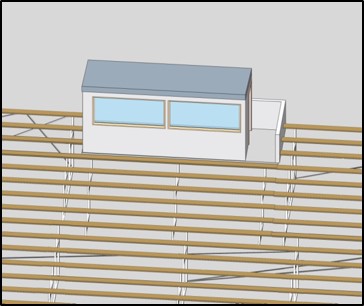
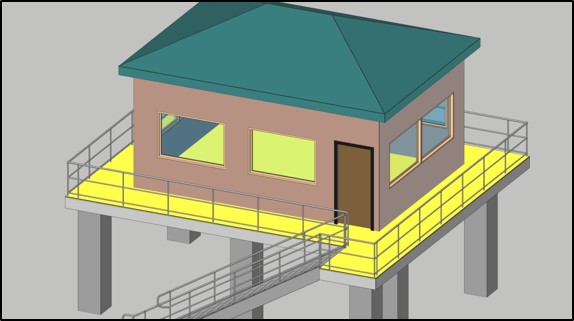
Recreation Facilities [§F206.2.8 – §F206.2.16]

The ABA Standards also address accessible routes to amusement rides, boating facilities, bowling lanes, court sports, exercise machines and equipment, fishing piers and platforms, golf and miniature golf facilities, and play areas.
Accessible Routes
[§402]
Components of accessible routes include walking surfaces, doorways, ramps, curb ramps, elevators, and, where permitted, platform lifts.
Components of Accessible Routes
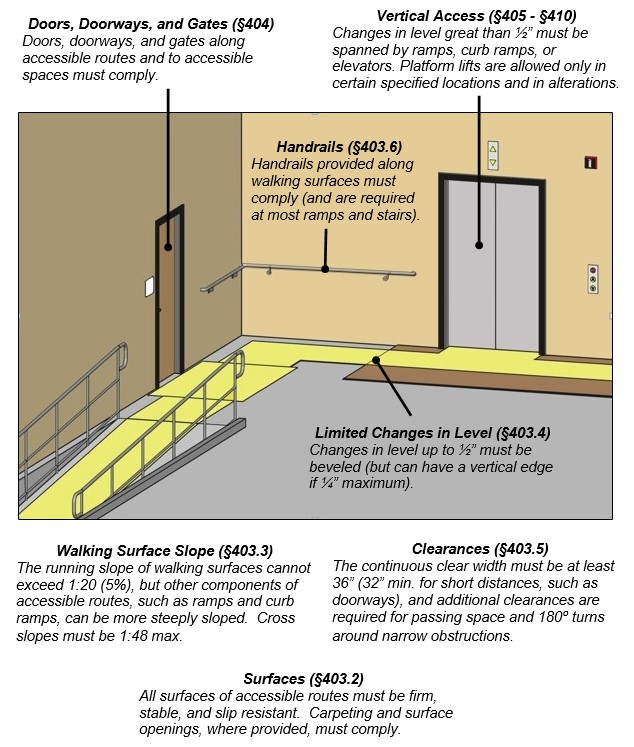
Clearances
[§403.5]
The minimum 36” continuous clear width of accessible routes can reduce to 32” at points, such as doorways, for a maximum distance of 24”. Greater clearance is required for 180 degree turns around narrow obstructions and for wheelchair turning space. The minimum clearance cannot be reduced by any elements, including handrails or protruding objects.
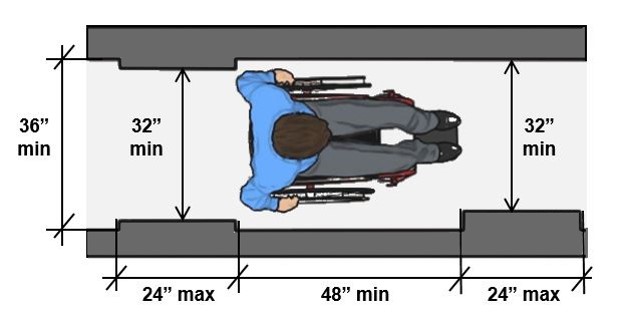
180 Turns Around Obstructions
Additional clearance is required at 180 degree turns around an element that is less than 48” wide. The clear width must be at least 48” at the turn and 42” minimum approaching the turn (unless the clear width at the turn is 60” minimum).
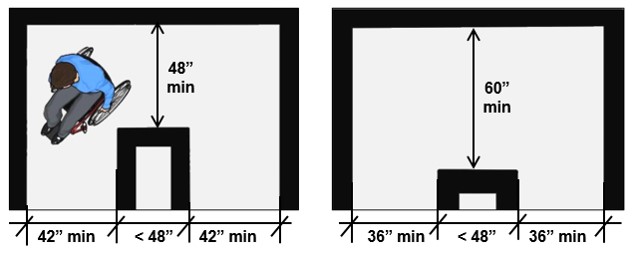
Passing Space
[§403.5.3]
Passing space is required every 200 feet and must be provided as a 60” by 60” minimum space or as T-shaped space where each stem is at least 48” long.
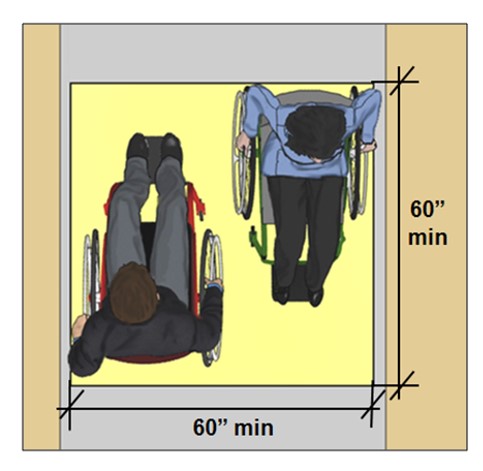 60” Min. by 60” Min. Passing Space
60” Min. by 60” Min. Passing Space
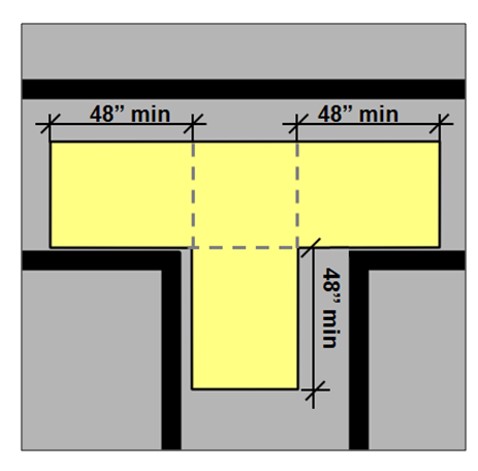 T-Shaped Passing Space
T-Shaped Passing Space
Handrails Along Walking Surfaces
Handrails are required at ramps with a rise greater than 6” and at stairs that are part of a means of egress, but not at other locations. Where handrails are provided along other portions walking surfaces, they must comply. (Handrails provided in elevator cabs or on platform lifts are not required to comply).
Handrails along Walking Surfaces

- 34” – 38” high measured to the top of the gripping surface.
- Gripping surface must be continuous the full length and top and sides cannot be obstructed.
- The bottom gripping surface can be obstructed up to 20% of the length (or along the full entire length when part of crash rails or bumper guards).
- No sharp or abrasive elements on gripping surfaces or adjacent surfaces, and no rotation within fittings.
Surface requirements and clearances facilitate a power grip along the length of handrails. Handrails can have circular or non-circular cross-sections, but must have rounded edges. The gripping surface and adjacent surfaces must be free of abrasive or sharp elements.
Circular Cross Section and Clearance (§505.5, §505.7)
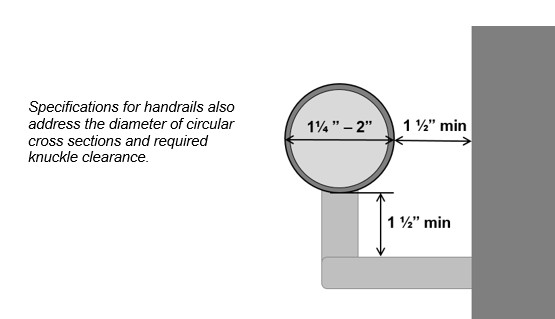
Non-Circular Cross Section and Clearance (§505.5, §505.7)
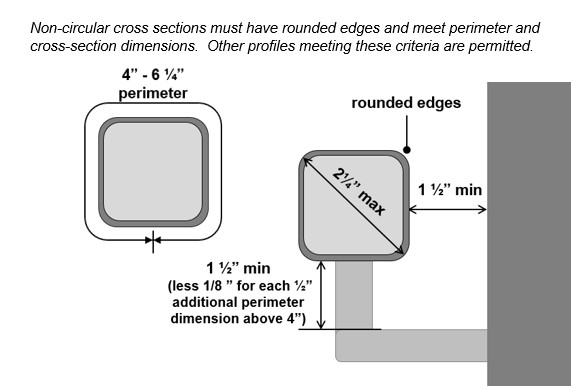
Common Questions

If no pedestrian route onto a site is provided, is an accessible route still required?
An accessible route from the boundary of the site is not required where the only means of site arrival is a vehicular way without pedestrian access. Where vehicular ways are also intended to accommodate pedestrian travel, such as a shopping center parking lot, an accessible route is required.
Do accessible routes that cross vehicular ways need to be marked as a crossing?
No, accessible routes that cross vehicular ways are not required by the Standards to be marked as a crossing. The Standards only require access aisles at accessible parking spaces and accessible passenger loading zones to be marked. (Local codes and traffic laws may require crossings to be marked).
Do stories not required to be on an accessible route have to comply with the Standards?
Yes, stories (and mezzanines) not connected by an accessible route must still meet all other applicable requirements in the Standards. This ensures access for people with disabilities who can use stairs and facilitates compliance should vertical access be achieved through later renovations or additions.
Do basements count in determining a facility’s story count?
As defined in the Standards, a “story” pertains to those portions of buildings “designed for human occupancy included between the upper surface of a floor and upper surface of the floor or roof next above” (§F106.5). A basement or other level below grade designed for human occupancy (i.e., equipped with lighting, ventilation, and means of egress) counts as a story. Basements or other levels not containing any space designed for human occupancy are not considered stories under the Standards.
Is an accessible route required to rooftop levels?
In facilities where an accessible route is required to each story (§F206.2.3), an accessible route must serve rooftop levels that contain public or common use spaces or elements that are required to be accessible, such as sun decks, lounges, dining areas, bars, or swimming pools.
When alterations are made on an upper story of a facility, is vertical access required?
If an alteration includes installation of a stair or escalator where none existed previously and involves major structural modifications, an accessible route between levels served by the stair or escalator is required (unless an accessible route already exists). If alterations are made to a primary function area on an upper floor, an accessible path of travel to the area is required to the extent that the cost is not disproportionate (i.e., more than 20% of the cost of the overall alteration). In any alteration, an accessible route between stories is not required in a facility that qualifies for those exceptions permitted in new construction based on the number of stories or square footage per floor.




